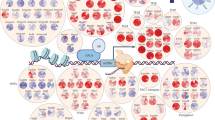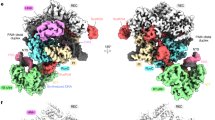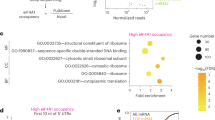Abstract
The antiviral and antiproliferative effects of interferons are mediated in part by the 2′-5′ oligoadenylate–RNase L RNA decay pathway. RNase L is an endoribonuclease that requires 2′-5′ oligoadenylates to cleave single-stranded RNA. In this report we present evidence demonstrating a role for RNase L in translation. We identify and characterize the human translation termination factor eRF3/GSPT1 as an interacting partner of RNase L. We show that interaction of eRF3 with RNase L leads to both increased translation readthrough efficiency at premature termination codons and increased +1 frameshift efficiency at the antizyme +1 frameshift site. On the basis of our results, we present a model describing how RNase L is involved in regulating gene expression by modulating the translation termination process.
This is a preview of subscription content, access via your institution
Access options
Subscribe to this journal
Receive 12 print issues and online access
$189.00 per year
only $15.75 per issue
Buy this article
- Purchase on Springer Link
- Instant access to full article PDF
Prices may be subject to local taxes which are calculated during checkout







Similar content being viewed by others
Accession codes
References
Isaacs, A. & Lindenmann, J. Virus interference. I. The interferon. Proc. R. Soc. Lond. B 147, 258–267 (1957).
Zhou, A., Hassel, B.A. & Silverman, R.H. Expression cloning of 2–5A-dependent RNAase: a uniquely regulated mediator of interferon action. Cell 72, 753–765 (1993).
Hassel, B.A., Zhou, A., Sotomayor, C., Maran, A. & Silverman, R.H. A dominant negative mutant of 2–5A-dependent RNase suppresses antiproliferative and antiviral effects of interferon. EMBO J. 12, 3297–3304 (1993).
Castelli, J.C. et al. The role of 2'-5′ oligoadenylate-activated ribonuclease L in apoptosis. Cell Death Differ. 5, 313–320 (1998).
Zhou, A. et al. Interferon action and apoptosis are defective in mice devoid of 2′,5′-oligoadenylate-dependent RNase L. EMBO J. 16, 6355–6363 (1997).
Le Roy, F. et al. The 2–5A/RNase L/RNase L inhibitor (RLI) pathway regulates mitochondrial mRNAs stability in interferon α-treated H9 cells. J. Biol. Chem. 276, 48473–48482 (2001).
Dong, B. & Silverman, R.H. 2–5A-dependent RNase molecules dimerize during activation by 2–5A. J. Biol. Chem. 270, 4133–4137 (1995).
Li, X.L., Blackford, J.A. & Hassel, B.A. RNase L mediates the antiviral effect of interferon through a selective reduction in viral RNA during encephalomyocarditis virus infection. J. Virol. 72, 2752–2759 (1998).
Maitra, R.K. & Silverman, R.H. Regulation of human immunodeficiency virus replication by 2′,5′-oligoadenylate-dependent RNase L. J. Virol. 72, 1146–1152 (1998).
Martinand, C. et al. RNase L inhibitor is induced during human immunodeficiency virus type 1 infection and down regulates the 2–5A/RNase L pathway in human T cells. J. Virol. 73, 290–296 (1999).
Behera, A.K., Kumar, M., Lockey, R.F. & Mohapatra, S.S. 2′-5′ Oligoadenylate synthetase plays a critical role in interferon-γ inhibition of respiratory syncytial virus infection of human epithelial cells. J. Biol. Chem. 277, 25601–25608 (2002).
Li, X.L. et al. RNase-L-dependent destabilization of interferon-induced mRNAs. A role for the 2–5A system in attenuation of the interferon response. J. Biol. Chem. 275, 8880–8888 (2000).
Bisbal, C. et al. The 2'-5′ oligoadenylate/RNase L/RNase L inhibitor pathway regulates both MyoD mRNA stability and muscle cell differentiation. Mol. Cell. Biol. 20, 4959–4969 (2000).
Khabar, K.S. et al. RNase L mediates transient control of the interferon response through modulation of the double-stranded RNA-dependent protein kinase PKR. J. Biol. Chem. 278, 20124–20132 (2003).
Dong, B., Niwa, M., Walter, P. & Silverman, R.H. Basis for regulated RNA cleavage by functional analysis of RNase L and Ire1p. RNA 7, 361–373 (2001).
Bisbal, C., Martinand, C., Silhol, M., Lebleu, B. & Salehzada, T. Cloning and characterization of a RNAse L inhibitor. A new component of the interferon-regulated 2–5A pathway. J. Biol. Chem. 270, 13308–13317 (1995).
Shetzline, S.E. et al. Structural and functional features of the 37-kDa 2–5A-dependent RNase L in chronic fatigue syndrome. J. Interferon Cytokine Res. 22, 443–456 (2002).
Salehzada, T., Silhol, M., Steff, A.M., Lebleu, B. & Bisbal, C. 2′,5′-Oligoadenylate-dependent RNase L is a dimer of regulatory and catalytic subunits. J. Biol. Chem. 268, 7733–7740 (1993).
Le Roy, F., Laskowska, A., Silhol, M., Salehzada, T. & Bisbal, C. Characterization of RNABP, an RNA binding protein that associates with RNase L. J. Interferon Cytokine Res. 20, 635–644 (2000).
Hoshino, S. et al. A human homologue of the yeast GST1 gene codes for a GTP-binding protein and is expressed in a proliferation-dependent manner in mammalian cells. EMBO J. 8, 3807–3814 (1989).
Frolova, L. et al. A highly conserved eukaryotic protein family possessing properties of polypeptide chain release factor. Nature 372, 701–703 (1994).
Zhouravleva, G. et al. Termination of translation in eukaryotes is governed by two interacting polypeptide chain release factors, eRF1 and eRF3. EMBO J. 14, 4065–4072 (1995).
Frolova, L. et al. Eukaryotic polypeptide chain release factor eRF3 is an eRF1- and ribosome-dependent guanosine triphosphatase. RNA 2, 334–341 (1996).
Hoshino, S. et al. Molecular cloning of a novel member of the eukaryotic polypeptide chain-releasing factors (eRF). Its identification as eRF3 interacting with eRF1. J. Biol. Chem. 273, 22254–22259 (1998).
Jakobsen, C.G., Segaard, T.M., Jean-Jean, O., Frolova, L. & Justesen, J. Identification of a novel termination release factor eRF3b expressing the eRF3 activity in vitro and in vivo. Mol. Biol. (Mosk.) 35, 672–681 (2001).
Le Goff, C. et al. Mouse GSPT2, but not GSPT1, can substitute for yeast eRF3 in vivo. Genes Cells 7, 1043–1057 (2002).
Kikuchi, Y., Shimatake, H. & Kikuchi, A. A yeast gene required for the G1-to-S transition encodes a protein containing an A-kinase target site and GTPase domain. EMBO J. 7, 1175–1182 (1988).
Hoshino, S., Imai, M., Kobayashi, T., Uchida, N. & Katada, T. The eukaryotic polypeptide chain releasing factor (eRF3/GSPT) carrying the translation termination signal to the 3′-Poly(A) tail of mRNA. Direct association of erf3/GSPT with polyadenylate-binding protein. J. Biol. Chem. 274, 16677–16680 (1999).
Uchida, N., Hoshino, S.I., Imataka, H., Sonenberg, N. & Katada, T. A novel role of the mammalian GSPT/eRF3 associating with poly(A)-binding protein in Cap/Poly(A)-dependent translation. J. Biol. Chem. 277, 50286–50292 (2002).
Wu, J.M., Konno, S. & Eslami, B. Effects of K+ concentration on inhibition of protein synthesis by trimer and tetramer triphosphates of 2′,5′-oligoadenylates in rabbit reticulocyte lysates. Biochem. Biophys. Res. Commun. 130, 821–827 (1985).
Dong, B. et al. Intrinsic molecular activities of the interferon-induced 2–5A-dependent RNase. J. Biol. Chem. 269, 14153–14158 (1994).
Kerr, I.M. & Brown, R.E. pppA2'p5'A2'p5'A: an inhibitor of protein synthesis synthesized with an enzyme fraction from interferon-treated cells. Proc. Natl. Acad. Sci. USA 75, 256–260 (1978).
Martin, E.M., Birdsall, N.J., Brown, R.E. & Kerr, I.M. Enzymic synthesis, characterisation and nuclear-magnetic-resonance spectra of pppA2'p5'A2'p5'A and related oligonucleotides: comparison with chemically synthesised material. Eur. J. Biochem. 95, 295–307 (1979).
Haugh, M.C. et al. Analogues and analogue inhibitors of ppp(A2'p)nA. Their stability and biological activity. Eur. J. Biochem. 132, 77–84 (1983).
Matsufuji, S. et al. Autoregulatory frameshifting in decoding mammalian ornithine decarboxylase antizyme. Cell 80, 51–60 (1995).
Ivanov, I.P., Gesteland, R.F., Matsufuji, S. & Atkins, J.F. Programmed frameshifting in the synthesis of mammalian antizyme is +1 in mammals, predominantly +1 in fission yeast, but −2 in budding yeast. RNA 4, 1230–1238 (1998).
Karamysheva, Z.N. et al. Antizyme frameshifting as a functional probe of eukaryotic translational termination. Nucleic Acids Res. 31, 5949–5956 (2003).
Howard, M.T. et al. Cell culture analysis of the regulatory frameshift event required for the expression of mammalian antizymes. Genes Cells 6, 931–941 (2001).
Sekar, V., Atmar, V.J., Joshi, A.R., Krim, M. & Kuehn, G.D. Inhibition of ornithine decarboxylase in human fibroblast cells by type I and type II interferons. Biochem. Biophys. Res. Commun. 114, 950–954 (1983).
Iwata, S. et al. Anti-tumor activity of antizyme which targets the ornithine decarboxylase (ODC) required for cell growth and transformation. Oncogene 18, 165–172 (1999).
Welch, E.M., Wang, W. & Peltz, S.W. Translation termination: it's not the end of the story. In Translational Control of Gene Expression (eds. Sonenberg, N., Hershey, J.W.B. & Mathews, M.B.) 467–485 (Cold Spring Harbor Laboratory Press, Cold Spring Harbor, New York, 2000).
Proweller, A. & Butler, J.S. Ribosomal association of poly(A)-binding protein in poly(A)-deficient Saccharomyces cerevisiae. J. Biol. Chem. 271, 10859–10865 (1996).
Otero, L.J., Ashe, M.P. & Sachs, A.B. The yeast poly(A)-binding protein Pab1p stimulates in vitro poly(A)-dependent and cap-dependent translation by distinct mechanisms. EMBO J. 18, 3153–3163 (1999).
Orlova, M., Yueh, A., Leung, J. & Goff, S.P. Reverse transcriptase of Moloney murine leukemia virus binds to eukaryotic release factor 1 to modulate suppression of translational termination. Cell 115, 319–331 (2003).
Grentzmann, G., Ingram, J.A., Kelly, P.J., Gesteland, R.F. & Atkins, J.F. A dual-luciferase reporter system for studying recoding signals. RNA 4, 479–486 (1998).
Acknowledgements
We thank F. Martin, O. Rouquier and D. Pappin for their help at the different steps of eRF3 protein purification and sequencing, A. Zhou for the gift of the Rnasel+/+ and Rnasel−/− mouse embryonic fibroblasts, J. Atkins for the gift of the antizyme dual luciferase plasmids and the members of the Peltz laboratory for helpful comments and critical reading of the manuscript. This work was supported by grants from the US National Institutes of Health (GM48631, AI057596) to S.W.P. and from the Association pour la Recherche contre le Cancer (4731) and La Ligue Contre le Cancer (Comités de l'Hérault et des Pyrénées-Orientales) for C.B. F.L.R. was partially funded by a postdoctoral award from the Philippe Foundation.
Author information
Authors and Affiliations
Corresponding authors
Ethics declarations
Competing interests
The authors declare no competing financial interests.
Supplementary information
Rights and permissions
About this article
Cite this article
Roy, F., Salehzada, T., Bisbal, C. et al. A newly discovered function for RNase L in regulating translation termination. Nat Struct Mol Biol 12, 505–512 (2005). https://doi.org/10.1038/nsmb944
Received:
Accepted:
Published:
Issue Date:
DOI: https://doi.org/10.1038/nsmb944
This article is cited by
-
Defects in TLR3 expression and RNase L activation lead to decreased MnSOD expression and insulin resistance in muscle cells of obese people
Cell Death & Disease (2014)
-
RNase L controls terminal adipocyte differentiation, lipids storage and insulin sensitivity via CHOP10 mRNA regulation
Cell Death & Differentiation (2012)
-
Expression, purification and characterization of the interferon-inducible, antiviral and tumour-suppressor protein, human RNase L
Journal of Biosciences (2012)
-
An update analysis of two polymorphisms in encoding ribonuclease L gene and prostate cancer risk: involving 13,372 cases and 11,953 controls
Genes & Nutrition (2011)
-
The iron–sulphur protein RNase L inhibitor functions in translation termination
EMBO reports (2010)



